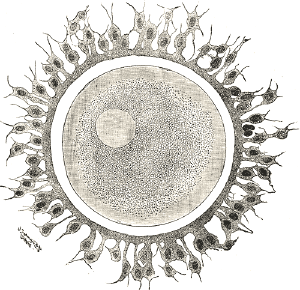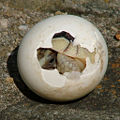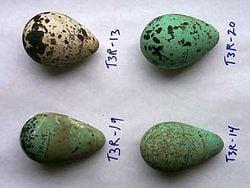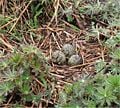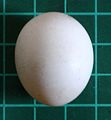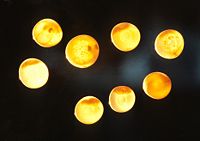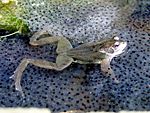Egg (biology)
In biology, egg may refer to a single female reproductive cell (or gamete), which is also called an ovum (plural ova), from the Latin word for egg. However, the term may also be used to describe the entire reproductive body that encloses the developing embryo in most birds, reptiles, amphibians, fish, and insects.
In contrast to the male gamete, or sperm, the egg contains more than just genetic material (DNA): it often includes nutrients (most of which are present in the yolk) and a protective covering, which may range from a single membrane in some invertebrates to the tough outer shell of many bird eggs. Hence, its large size relative to spermatozoa and other cells: the ovum is the largest cell in the human body, typically visible to the naked eye without the aid of a microscope. Plant eggs are the exception because they do not need to contain nutritive materials; the developing sporophyte embryo is nourished until self-supporting by the plant on which it is formed.
Like spermatozoa, eggs are haploid, meaning that they contain one set of chromosomes. In some species that engage in a form of asexual reproduction called parthenogenesis, the eggs remain unfertilized; that is, they do not join their genetic information to male gametes to produce diploid cells (which contain two sets of chromosomes). A fertilized egg, in contrast, is called a zygote.
There are three main types of egg-laying devices among animals, depending on the environmental conditions and reproductive needs of the organism, which in turn determines the structure and properties of the egg and of the mother’s reproductive anatomy:
- Under the system of oviparity, animals lay eggs in the environment, and their embryos develop outside of the mother’s body. Terrestrial animals, such as birds, who cannot lay their eggs in aquatic environments, must protect eggs from drying out; their eggs have waterproof outer membranes or shells, which can also be effective protection against predators.
- In viviparous animals, which include humans and all other placental mammals, the embryo develops inside the uterus, receiving nutrition directly from the mother; hence, the egg does not require vast stores of nutrients to survive the early stages of development.
- Nonmammals such as sharks, who retain the eggs in the mother’s body until they hatch, but do not directly nourish the embryo, engage in a reproductive system called ovoviviparity.
In addition to the method of laying eggs, more on various sizes and shapes of eggs. The 1.5 kg ostrich egg contains the largest existing single cell currently known, while the Bee Hummingbird produces the smallest-known bird egg, which weighs half a gram. Point to the gallery below for more diversity:
A baby tortoise emerges from its egg.
Fish eggs, such as these herring eggs, are often transparent in appearance. They are fertilized by the male after laying.
Components
text?
Shelled eggs
Reptile eggs, bird eggs, and monotreme eggs (huh?), which are laid out of water, are surrounded by a protective shell, either flexible or inflexible.
Bird eggs are laid by females and incubated for a time that varies according to the species; a single chick hatches from each egg. Average clutch sizes range from one (as in condors) to about 17 (the Grey Partridge). Some birds lay eggs even when not fertilized; it is not uncommon for pet owners to find their lone bird nesting on a clutch of infertile eggs.
Something about design: must be tough and waterproof, but must also enable the exchange of gases: Tiny pores in bird eggshells allow the embryo to breathe. The domestic hen's egg has around 7500 pores
Something on basic structure?
Colors
The default color of vertebrate eggs is the white of the calcium carbonate from which the shells are made (but not all vertebrates produce shelled eggs), but some birds, mainly passerines, produce colored eggs. The pigments biliverdin and its zinc chelate give a green or blue ground color, and protoporphyrin produces reds and browns as a ground color or as spotting. (emphasize the function of coloring and spotting earlier in the section)
Non-passerines typically have white eggs, except in some ground-nesting groups such as the Charadriiformes, sandgrouse and nightjars, where camouflage is necessary, and some parasitic cuckoos which have to match the passerine host's egg.
However, a recent study suggests that the protoporphyrin markings on passerine eggs actually act to reduce brittleness by acting as a solid-state lubricant. If there is insufficient calcium available in the local soil, the egg shell may be thin, especially in a circle around the broad end. Protoporphyrin speckling compensates for this, and increases inversely to the amount of calcium in the soil.
For the same reason, later eggs in a clutch are more spotted than early ones as the female's store of calcium is depleted.
The color of individual eggs is also genetically influenced, and appears to be inherited through the mother only, suggesting that the gene responsible for pigmentation is on the sex determining W chromosome (female birds are WZ, males ZZ).
It used to be thought that color was applied to the shell immediately before laying, but this research shows that coloration is an integral part of the development of the shell, with the same protein responsible for depositing calcium carbonate, or protoporphyrins when there is a lack of that mineral.
In species such as the Common Guillemot, which nest in large groups, each female's eggs have very different markings, making it easier for females to identify their own eggs on the crowded cliff ledges on which they breed.
Texture
(again, explain the function of the shell!) Bird eggshells are diverse. For example:
- cormorant eggs are rough and chalky
- tinamou eggs are shiny
- duck eggs are oily and waterproof
- cassowary eggs are heavily pitted
(maybe explain this diversity as a function of specific adaptations to environment and niche, a complex array that results from the prime importance of sophisticated reproductive strategies; combine color, shape, and shell into one section that highlights the diversity of shelled eggs and their evolutionary rationale?)
Shape
Most bird eggs have an oval shape, with one end rounded and the other more pointy. This shape results from the egg being forced through the oviduct. Muscles contract the oviduct behind the egg, pushing it forward. The egg's wall is still shapeable, and the pointy end develops at the back side. Cliff-nesting birds often have highly conical eggs. They are less likely to roll off, tending instead to roll around in a tight circle, and thus are believed to have been selected for by evolution. In contrast many hole-nesting birds have nearly spherical eggs.
Egg maturation
Oocyte and oogonia (immature ovum)
In species that repeatedly release 100s or 1000s of eggs, oogonia remain capable of mitotic division throughout life. In animals that produce relatively few eggs throughout their life span, the proliferation of oogonia is limited to an early period during which all the egg precursor cells the individual will ever have form (in humans, this period ends before birth)
Eggs (ova) are produced and released by the female gonads (the ovaries), which are paired structures in the lower part of the body cavity of whom?
At birth, female human has about a million primary oocytes in each ovary; by time of sexual maturity, only 200,000
Ovarian cycles of placental mammals: one oocyte fully matures and releases
Predation
Many animals feed on eggs. For example, principal predators of the Black Oystercatcher's eggs include raccoons, skunks, mink, river and sea otters, gulls, crows and foxes. The stoat (Mustela erminea) and long-tailed weasel (M. frenata) steal ducks' eggs. Snakes of the genera Dasypeltis and Elachistodon specialize in eating eggs.
Brood parasitism occurs in birds when one species lays its eggs in the nest of another. In some cases, the host's eggs are removed or eaten by the female, or expelled by her chick. Brood parasites include the cowbirds and many Old World cuckoos.
The evolution of the egg
Evolution of the shelled egg: reptiles were first vertebrate group to solve the problem of reproduction in a terrestrial (v. aquatic) environment, a solution shared by birds; the shell must be permeable to respiratory gases and reasonably impermeable to water; but the shelled egg created a new problem for fertilization; sperm cannot penetrate the shell, so they have to reach the egg before the shell forms
Solution to this problem was internal fertilization; hence, the necessary accessory organs evolved; mammals have retained internal fertilization but have done away w/ the shelled egg by keeping the developing embryo in the female reproductive tract until it’s capable of independent existence in the outside environment
Types of egg-laying (reword)

The most common reproductive strategy for fish is known as oviparity, in which the female lays undeveloped eggs that are externally fertilized by a male. Typically large numbers of eggs are laid at one time (an adult female cod can produce 4–6 million eggs in one spawning) and the eggs are then left to develop without parental care. When the larvae hatch from the egg, they often carry the remains of the yolk in a yolk sac which continues to nourish the larvae for a few days as they learn how to swim. Once the yolk is consumed, there is a critical point after which they must learn how to hunt and feed or they will die.
A few fish, notably the rays and most sharks use ovoviviparity in which the eggs are fertilized and develop internally. However the larvae still grow inside the egg consuming the egg's yolk and without any direct nourishment from the mother. The mother then gives birth to relatively mature young. In certain instances, the most physically developed offspring will devour its smaller siblings for further nutrition while still within the mother's body. This is known as intrauterine cannibalism.
More rarely, some fish such as the hammerhead shark and reef shark are viviparous, with the egg being fertilized and developed internally, but with the mother also providing direct nourishment.
Reptile eggs are often rubbery and are always initially white. Often the sex of the developing embryo is determined by the temperature of the surroundings, with cooler temperatures favoring males. Not all reptiles lay eggs; some are viviparous.
Like fish eggs, amphibian eggs are jellylike and are fertilized externally. They also do not have a shell and therefore need to be laid in water or protective foam as with the Coast foam-nest treefrog, Chiromantis xerampelina.
Other than extinct species, mammal eggs are laid only by Australian monotremes: the platypus and two genera of echidna (spiny anteaters).
In the oviparous animals (all birds, most fishes, amphibians and reptiles) the ova develop protective layers and pass through the oviduct to the outside of the body. They are fertilized by male sperm either inside the female body (as in birds), or outside (as in many fishes). After fertilization, an embryo develops, nourished by nutrients contained in the egg. It then hatches from the egg, outside the mother's body. See egg (biology) for a discussion of eggs of oviparous animals.
The egg cell's cytoplasm and mitochondria (and chloroplasts in plants) are the sole means of the egg being able to reproduce by mitosis and eventually form a blastocyst after fertilization.
There is an intermediate form, the ovoviviparous animals: the embryo develops within and is nourished by an egg as in the oviparous case, but then it hatches inside the mother's body shortly before birth, or just after the egg leaves the mother's body. Some fish, reptiles and many invertebrates use this technique.
Protist and plant ova
In protists, fungi and many plants, such as bryophytes, ferns, and gymnosperms, ova are produced inside archegonia. Since the archegonium is a haploid structure, egg cells are produced via mitosis. The typical bryophyte archegonium consists of a long neck with a wider base containing the egg cell. Upon maturation, the neck opens to allow sperm cells to swim into the archegonium and fertilize the egg. The resulting zygote then gives rise to an embryo, which will grow out of the archegonium as a sporeling (a young sporophyte).
In the flowering plants, the female gametophyte, which usually gives rise to the archegonium, has been reduced to just eight cells referred to as the embryo sac inside the ovule. The gametophyte cell closest to the micropyle opening of the embryo sac develops into the egg cell. Upon pollination, a pollen tube delivers sperm into the embryo sac and one sperm nucleus fuses with the egg nucleus. The resulting zygote develops into an embryo inside the ovule. The ovule in turn develops into a seed and in many cases the plant ovary develops into a fruit to facilitate the dispersal of the seeds. Upon germination, the embryo grows into a seedling.
ReferencesISBN links support NWE through referral fees
- Fernandez, T. 2002. Marine Biology notes. School of Life Sciences, Napier University. Retrieved August 7, 2007.
- Gosler, A. 2006. Yet even more ways to dress eggs. British Birds 99(7):338-53.
- Pickrell, J. 2005. Speckles Make Bird Eggs Stronger, Study Finds. National Geographic News. Retrieved August 7, 2007.
- Purves, W., D. Sadava, G. Orians, and C. Heller. 2004. Life: The Science of Biology, 7th ed. Sunderland, MA: Sinauer.
Credits
New World Encyclopedia writers and editors rewrote and completed the Wikipedia article in accordance with New World Encyclopedia standards. This article abides by terms of the Creative Commons CC-by-sa 3.0 License (CC-by-sa), which may be used and disseminated with proper attribution. Credit is due under the terms of this license that can reference both the New World Encyclopedia contributors and the selfless volunteer contributors of the Wikimedia Foundation. To cite this article click here for a list of acceptable citing formats.The history of earlier contributions by wikipedians is accessible to researchers here:
The history of this article since it was imported to New World Encyclopedia:
Note: Some restrictions may apply to use of individual images which are separately licensed.
